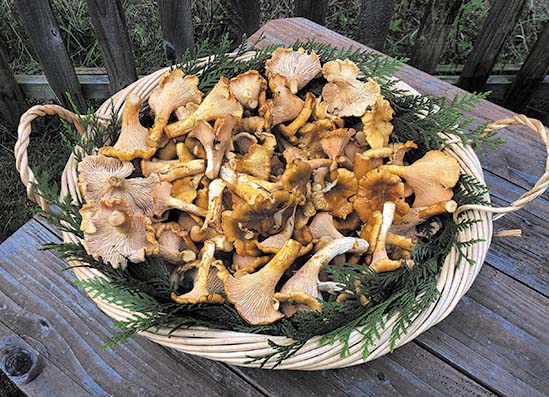
Submitted by AnneCherise Jensen
People from many cultures have a long history of gathering mushrooms for food, medicine, dyes, clothing and decoration. Over the centuries, humans have accumulated a considerable amount of knowledge about mushrooms, whether they be poisonous, edible or medicinal species. However, because of their variety of health effects, many people have steered away from incorporating wild mushrooms and other fungi into their diet.
Mushrooms are a common, and plentiful wild edibles that grows naturally in the Pacific Northwest. If we have the proper tools, hands on experience, education and resources, we can easily identify and locate some edible species and incorporate them into our diet. This article will dive deeper into some common variations of local, edible mushrooms, their health properties, and how to incorporate them into meals in the kitchen. Let’s get started!
Did you know that there are over 2,000 varieties of edible mushrooms? In fact, there are actually more species of edible mushrooms than poisonous mushrooms. Most poisonous mushrooms won’t kill you, side effects usually include upset stomach, vomiting and/or food poisoning symptoms. Some common poisonous mushrooms grown in the PNW include Sulfur Tufts and certain types of Amanitas. Keep in mind, poisonous mushrooms are only harmful when eaten. The harmful toxins they contain cannot penetrate the skin, and won’t harm you if touched, only digested. Make sure to always cross reference a species before consuming.
Edible mushrooms are tasty, nutritious and can be used in a wide variety of dishes. Mushrooms contain the 5th flavor called umami, which is also known as savory and having a meat-like taste and texture. In fact, mushrooms can often be used as a meat substitute in the kitchen. Foraging for local mushrooms is an economical and nutritious way to enhance meals at home (they’re free). There are thousands of nutrient dense mushrooms in the forest just waiting to be eaten. The best part is the more you forage wild mushrooms, the more abundant they grow the following year. Here are some tips to help you on your next mushroom forage.
Mushroom Foraging Tips:
- Spring and Autumn are the best months to forage for mushrooms. Winter temps are usually too cold with snow and frost on the ground, while Summer is typically too hot and dry. Some species grow all year round, but generally mushrooms prefer moist damp soils in the cooler months. This is a great hobby to pick up especially in Fall.
- Don’t pick or eat mushrooms that you don’t know are safe. Be sure to study field guide books before and after a mushroom forage. Use multiple identification books to properly identify before consuming.
- Be sure to bring a basket to carry your foraged mushrooms in. Having holes at the bottom of the basket allows the spores (mushroom seeds) to fall onto the ground and allow for more potential fungi growth in the forest.
- Start by searching your local forests. Go on a walk in the woods. Search for mushrooms on the ground, in the soil, on the fallen trees, and in the timber. Observe what types of mushrooms you find, take a couple pictures from different angles. Go home and research what you saw.
- Go mushroom foraging after a few days of rain. Mushrooms and other fungi require lots of rain and water for them to grow and thrive. This will increase your chances of finding fresh, healthy specimens.
- “Choose mushrooms with a firm texture, even color and tightly closed caps. They can be stored in the refrigerator in a paper bag for up to one week, but best used within a few days. To prep: Brush them off with your finger then rinse and pat dry with a paper towel or clean towel. Some mushrooms, such as shiitakes, should have their stem trimmed before cooking”. (Wolfram)
- Be prepared. Other common tools used on a mushroom forage include a pocket knife, field guide book, camera or phone, and family or friends to share the experience with.
Common species of locally foraged, edible mushrooms:
There are over 100 species of edible mushrooms that are common in the Pacific Northwest region. Some species are rarer and some are generally easier to find. Here are five common wild mushrooms I’ve personally identified and located in our region, starting from most common to least common.
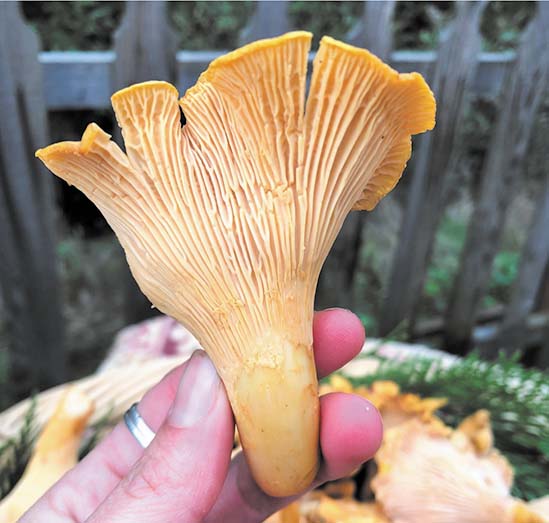
Chanterelles: Chanterelles rank among the most popular edible wild mushrooms. Chanterelles are usually vase or trumpet-shaped mushrooms with wavy-like gills. This mushroom has a fruity, apricot-like aroma and mild, peppery taste. Most are yellow or orange. In its healthiest form, this is a very firm & rigid mushroom, don’t harvest if mushy or gooey.
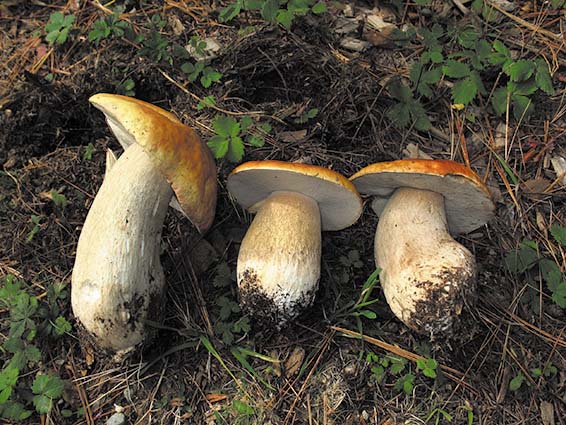
King Bolete: There are about 20 different types of Boletes that grow in the Pacific Northwest. They contain spores underneath their caps, and are usually very spongy. Most Boletes are edible, but vary in flavor. The King Bolete is one of the most common edible Boletes in this region. They are medium to large in size, caps are usually yellow-brown, red-brown, or dark red. This is the largest Bolete and is usually pretty easy to identify.
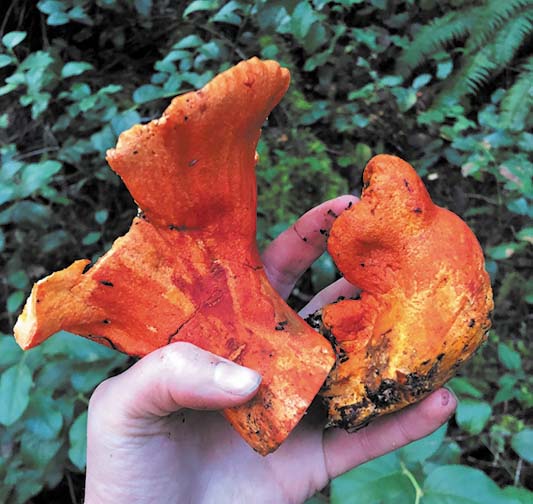
Lobster Mushrooms: Medium to large sized mushroom, in a layer of bright orange to vibrant red tissues, usually shaped like an upside down pyramid. Found in woods, especially under conifer trees in the Pacific Northwest. Lots of flavor and considered a high quality edible. With its unique vibrant red colors, this mushroom is one of the easiest to identify.
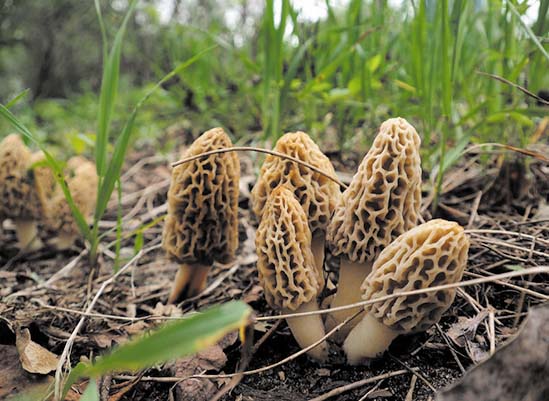
Morel: Morels have a distinctive honeycomb-like shape and vary in color from light yellow to dark brown. They are earthy in flavor and should be cooked before eating. However, these are usually only harvested in the spring months in recent forest burn areas.
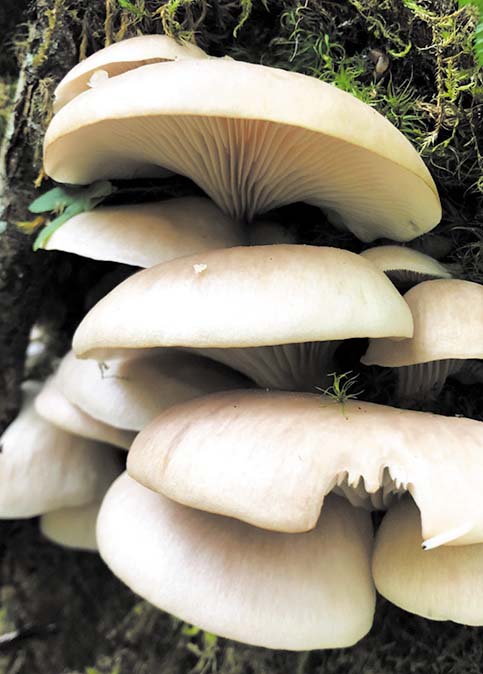
Oyster Mushroom: Oyster mushrooms are usually white, light grey or light yellow. They are smooth, trumpet-shaped that grow in clusters and have a light flavor. There are a few species of oyster mushrooms. All are edible but vary in flavor, color and shape.
Mushroom Identification Resources: Below are some mushroom identification books that I use frequently. There are others out there, but these are just a few that I’ve used. I find it helpful to use books that are specific to your area. Mushrooms of the PNW is probably my most used and helpful book. Check your local bookstore or find these off Amazon.
- The Fungal Pharmacy: Robert Rodgers
- Mushrooms of the Pacific Northwest: Steve Trudell & Joe Ammirati
- All That Rain Promises and More… : David Arora
- National Audubon Society Field Guide to North American Mushrooms: Gary H. Lincoff
- Mushrooms – How to Identify & Gather Wild Mushrooms & Other Fungi: Thomas Laessoe
Nutrition Properties
“One cup of raw sliced mushrooms has approximately 20 calories and are a good source of potassium and, depending on the variety, can provide selenium and copper. Mushrooms have significant amounts of three B-complex vitamins: riboflavin, niacin and pantothenic acid. The B vitamins help release energy from the fat, protein and carbohydrates in food. They also can be excellent sources of vitamin D if they have been exposed to ultraviolet light right before or after harvesting”. (Wolfram)
Cooking & Consuming
Mushrooms provide a wide range of flavors and opportunity in the kitchen. However, when first starting to eat wild edible mushrooms, it’s best to start by eating them in small portions. Some individuals have a hard time digesting wild mushrooms and get a mild upset stomach at first. The best way to overcome this, is to start with small portions and gradually eat more wild mushrooms as you get more comfortable with them. A suggestion to those who pick a mushroom variety for the first time – have an adult cook and taste a small amount of the mushroom first, and wait 24 hours to be sure there is no reaction, before making a large portion to serve to family, especially kids. When cooking, make sure the mushrooms are fully cooked, usually about 10-20 minutes of frying, steaming, sautéing, or baking will cook them thoroughly.
Sources:
- All That the Rain Promises and More.. : by David Arora
- Mushrooms of the Pacific Northwest : Steve Trudell & Joe Ammirati
- **This material was funded by USDA’s Supplemental Nutrition Assistance Program – SNAP. This institution is an equal opportunity provider.